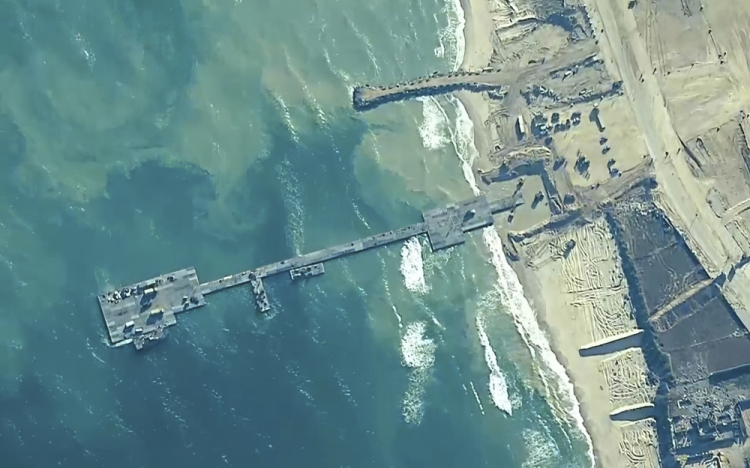With the US troops ending its mission in Gaza, many label the $230 million pier a failure.

The humanitarian aid operation to Gaza, which was hampered by recurrent weather and security issues that restricted the amount of food and other supplies that could reach the starving Palestinians, will come to an end when the U.S. military-built dock is demolished and returned home.

At a Pentagon briefing on Wednesday, Vice Adm. Brad Cooper, deputy commander of U.S. Central Command, informed reporters that the pier had the desired impact in what he described as a “unprecedented operation.”

Israel’s current proposal to use the port at Ashdod as a replacement is being questioned as the U.S. military withdraws from using the maritime route to deliver humanitarian aid. There are still questions about whether humanitarian organizations will have enough safe land crossings to deliver supplies into the area under siege by Israel and Hamas, as well as a lack of information over how it will operate. However, the Ashdod corridor will be more sustainable, according to Cooper.
ALSO READ: Israeli attack on Gaza targets the head of Hamas’ military branch, killing 71
The pier is criticized as a $230 million waste of money that hasn’t managed to attract the kind of assistance required to stop an impending famine. But the U.S. military has insisted that it provided the best chance for the Palestinians, having delivered about 20 million pounds (9 million kilograms) of much-needed supplies during a critical period of near-famine in Gaza.

In his March State of the Union address, President Joe Biden, who had announced the pier’s construction, expressed dissatisfaction that it had not gone as well as planned.
The Democratic candidate Joe Biden expressed his disappointment last week at a news conference, saying, “I’ve been disappointed that some of the things that I put forward have not succeeded as well—like the port we attached from Cyprus.” “I thought that would have more success.”
Initially conceived as a stopgap measure to provide food to Palestinians in need, the project was derided from the outset by humanitarian organizations who deemed it an inefficient use of resources. Officials from the U.S. defense department admitted that the weather was harsher than anticipated and restricted the number of days the pier could be used, but they were also angry at humanitarian organizations for their inability and refusal to deliver the material that passed through the system, only for it to accumulate onshore.

A crucial factor that remained beyond the purview of both assistance organizations and the US military, nevertheless, was the Israeli defense forces, whose incursion into Gaza placed relief workers in constant risk and frequently resulted in their deaths.
Consequently, the pier was only in use for roughly half of the time it was open after it was installed on May 16—less than 25 days—because of security concerns.

The more than 1,000 American soldiers and sailors, who mostly resided aboard boats off the coast of Gaza, were stuck in the midst. They tried their hardest to maintain the pier’s functionality but were forced to spend many days fixing it or removing it, moving it, and reinstalling it because of the severe weather.
Tensions persisted until the very end as senior Biden administration officials announced the project’s termination several days prior, but U.S. Central Command objected, clinging to the notion that the military may reinstall it in order to get any remaining assistance packages ashore.
Most people would concur that early expectations were not met by the Army’s Joint Logistics Over the Shore, or JLOTS, or by using the marine route. Authorities had already issued a warning about potential difficulties due to the shallow sea, erratic weather, and the area’s ongoing conflict.
Since U.S. troops have not been allowed to enter Gaza since the start of the Hamas-Israel conflict in October, the U.S. also had to teach Israeli troops and others on how to anchor the pier to the shore.

Nonetheless, the United States Agency for International Development, which worked with the UN and other organizations to distribute supplies to those in need, claims that enough aid passed through the dock to feed 450,000 people for a month. Humanitarian leaders assert that the pier operation was crucial in laying the foundation for a system of coordination with the Israeli military and government that they can build upon.
The pier, which went online during a period of some of the worst hopelessness and food shortages, was the one location where deconfliction with the Israeli military functioned effectively, according to USAID Administrator Samantha Power. According to her, the military and Israel have now decided to include “all of Gaza” in the coordinating plan.

Israeli Defense Minister Yoav Gallant announced on Tuesday that the U.S. military-built Pier 28 will be replaced by a new structure at Israel’s Ashdod port that will facilitate the delivery of aid to the Gaza Strip. He did not specify when it would begin to function.



Pingback: Gaza attacks after a weekend assault left several dead